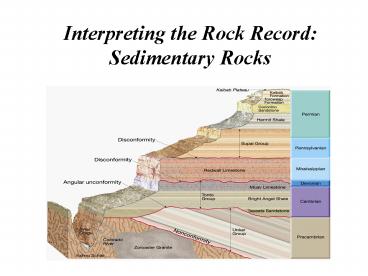Interpreting the Rock Record: Sedimentary Rocks - PowerPoint PPT Presentation
1 / 28
Title:
Interpreting the Rock Record: Sedimentary Rocks
Description:
Conglomerate and breccia. Both are composed of particles greater than 2mm in diameter. Conglomerate consists largely of rounded gravels ... – PowerPoint PPT presentation
Number of Views:269
Avg rating:3.0/5.0
Title: Interpreting the Rock Record: Sedimentary Rocks
1
Interpreting the Rock RecordSedimentary Rocks
2
Parks of the Colorado Plateau Spanning the
Time Scale!
3
Reconstructing the Past
- The oldest rocks in the Canyon (exposed in the
innermost gorges) are igneous and
metamorphic.Rama Schist gneissBrahma
SchistVishnu SchistZoroaster Granite (though
more are present) - These rocks contain evidence of past collisions
and rifting, representing the formation of giant
supercontinent Rodinia and are the roots of an
ancient mountain range The Mazatzal.
4
Reconstructing the Past
5
Reconstructing the Past 1.7 Ga
6
Reconstructing the Past 1.1 Gapart of
supercontinent Rodinia
7
Interpreting the Rock RecordSedimentary Rocks
8
What is a sedimentary rock?
- Sedimentary rocks are products of mechanical and
chemical weathering - They account for about 5 percent (by volume) of
Earths outer 10 miles - Contain evidence of past environments
- Provide information about sediment transport and
deposition - Often contain fossils
9
Turning sediment into rock
- Many changes occur to sediment after it is
deposited - Diagenesis all of the chemical, physical, and
biological changes that take place after
sediments are deposited - Occurs within the upper few kilometers of Earths
crust
10
Turning sediment into rock
- Diagenesis
- Includes
- Recrystallization development of more stable
minerals from less stable ones - Lithification unconsolidated sediments are
transformed into solid sedimentary rock by
compaction and cementation - Natural cements include calcite, silica, and iron
oxide
11
Types of sedimentary rocks
- Sediment originates from mechanical and/or
chemical weathering - Rock types are based on the source of the
material - Detrital rocks transported sediment as solid
particles - Chemical rocks sediment that was once in
solution
12
Detrital sedimentary rocks
- The chief constituents of detrital rocks include
- Clay minerals
- Quartz
- Feldspars
- Micas
- Particle size is used to distinguish among the
various types of detrital rocks
13
Detrital sedimentary rocks
- Common detrital sedimentary rocks (in order of
increasing particle size) - Shale
- Mud-sized particles in thin layers that are
commonly referred to as laminea - Most common sedimentary rock
14
Detrital sedimentary rocks
- Sandstone
- Composed of sand-sized particles
- Forms in a variety of environments
- Sorting, shape, and composition of the grains can
be used to interpret the rocks history - Quartz is the predominant mineral
15
Detrital sedimentary rocks
- Conglomerate and breccia
- Both are composed of particles greater than 2mm
in diameter - Conglomerate consists largely of rounded gravels
- Breccia is composed mainly of large angular
particles
16
Chemical sedimentary rocks
- Consist of precipitated material that was once in
solution - Precipitation of material occurs in two ways
- Inorganic processes
- Organic processes (biochemical origin)
17
Chemical sedimentary rocks
- Common chemical sedimentary rocks
- Limestone
- Most abundant chemical rock
- Composed chiefly of the mineral calcite
- Marine biochemical limestones form as coral
reefs, coquina (broken shells), and chalk
(microscopic organisms) - Inorganic limestones include travertine and
oolitic limestone
18
Chemical sedimentary rocks
- Common chemical sedimentary rocks
- Dolostone
- Typically formed secondarily from limestone
- Chert
- Made of microcrystalline quartz
- Varieties include flint and jasper (banded form
is called agate)
19
Chemical sedimentary rocks
- Common chemical sedimentary rocks
- Evaporites
- Evaporation triggers deposition of chemical
precipitates - Examples include rock salt and rock gypsum
20
Classification of sedimentary rocks
- Sedimentary rocks are classified according to the
type of material - Two major groups
- Detrital
- Chemical
21
Classification of sedimentary rocks
- Two major textures are used in the classification
of sedimentary rocks - Clastic
- Discrete fragments and particles
- All detrital rocks have a clastic texture
- Nonclastic
- Pattern of interlocking crystals
- May resemble an igneous rock
22
(No Transcript)
23
Sedimentary environments
- A geographic setting where sediment is
accumulating - Determines the nature of the sediments that
accumulate (grain size, grain shape, etc.)
24
Continental (left) and marine (right)
depositional environments
25
Sedimentary environments
- Sedimentary facies
- Different sediments often accumulate adjacent to
one another at the same time - Each unit (called a facies) possesses a
distinctive set of characteristics reflecting the
conditions in a particular environment - The merging of adjacent facies tends to be a
gradual transition
26
Sedimentary facies
27
Interpreting the Rock RecordGrand Canyon
28
Interpreting the Rock RecordNeoproterozoic
Rifting and the Grand Canyon Supergroup































